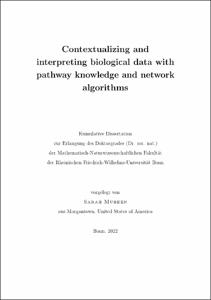Mubeen, Sarah: Contextualizing and interpreting biological data with pathway knowledge and network algorithms. - Bonn, 2023. - Dissertation, Rheinische Friedrich-Wilhelms-Universität Bonn.
Online-Ausgabe in bonndoc: https://nbn-resolving.org/urn:nbn:de:hbz:5-69744
Online-Ausgabe in bonndoc: https://nbn-resolving.org/urn:nbn:de:hbz:5-69744
@phdthesis{handle:20.500.11811/10617,
urn: https://nbn-resolving.org/urn:nbn:de:hbz:5-69744,
author = {{Sarah Mubeen}},
title = {Contextualizing and interpreting biological data with pathway knowledge and network algorithms},
school = {Rheinische Friedrich-Wilhelms-Universität Bonn},
year = 2023,
month = feb,
note = {Elucidating the mechanisms which give rise to unique biological functions is a major goal of human biology. Vast quantities of biological data that have been amassed can aid us in understanding these mechanisms, such as at the level of gene expression, protein expression and metabolites, although piecing together these various components can be an arduous undertaking. Though it may be difficult to ascertain the interplay of these entities, living organisms are complex and composed of highly interconnected and interdependent systems, thus requiring system-wide investigations. To that end, the complex interplay of biological entities can be modelled in interaction networks on which various computational approaches can subsequently be applied. In this work, we augment existing network-based approaches and introduce novel ones towards the aim of building a more comprehensive picture of the mechanisms that regulate health and disease. Firstly, we address this goal by building upon existing techniques for the interpretation of high dimensional data through its representation as biological pathways. We integrate pathway knowledge dispersed across heterogeneous resources for a more comprehensive overview of the current knowledge surrounding a particular biological process under investigation. We also outline how various aspects of widely-used pathway analyses contribute to either sound or misinterpretations. Secondly, we combine a knowledge and data-driven approach in order to contextualize gene expression data and reveal transcriptional patterns underlying discrete biological functions across four distinct contexts (i.e., disease, tissue, cell type and cell line). Thirdly, we introduce novel network-based methodologies for biomedical applications. These include implementations of network diffusion algorithms alongside of several multimodal biological networks to operate on, as well as a pathfinding algorithm for drug discovery. In conclusion, compiling biological data into networks of interacting molecular entities and biological constructs enables us to achieve ever-increasing levels of discernment of the mechanisms that govern health and disease.},
url = {https://hdl.handle.net/20.500.11811/10617}
}
urn: https://nbn-resolving.org/urn:nbn:de:hbz:5-69744,
author = {{Sarah Mubeen}},
title = {Contextualizing and interpreting biological data with pathway knowledge and network algorithms},
school = {Rheinische Friedrich-Wilhelms-Universität Bonn},
year = 2023,
month = feb,
note = {Elucidating the mechanisms which give rise to unique biological functions is a major goal of human biology. Vast quantities of biological data that have been amassed can aid us in understanding these mechanisms, such as at the level of gene expression, protein expression and metabolites, although piecing together these various components can be an arduous undertaking. Though it may be difficult to ascertain the interplay of these entities, living organisms are complex and composed of highly interconnected and interdependent systems, thus requiring system-wide investigations. To that end, the complex interplay of biological entities can be modelled in interaction networks on which various computational approaches can subsequently be applied. In this work, we augment existing network-based approaches and introduce novel ones towards the aim of building a more comprehensive picture of the mechanisms that regulate health and disease. Firstly, we address this goal by building upon existing techniques for the interpretation of high dimensional data through its representation as biological pathways. We integrate pathway knowledge dispersed across heterogeneous resources for a more comprehensive overview of the current knowledge surrounding a particular biological process under investigation. We also outline how various aspects of widely-used pathway analyses contribute to either sound or misinterpretations. Secondly, we combine a knowledge and data-driven approach in order to contextualize gene expression data and reveal transcriptional patterns underlying discrete biological functions across four distinct contexts (i.e., disease, tissue, cell type and cell line). Thirdly, we introduce novel network-based methodologies for biomedical applications. These include implementations of network diffusion algorithms alongside of several multimodal biological networks to operate on, as well as a pathfinding algorithm for drug discovery. In conclusion, compiling biological data into networks of interacting molecular entities and biological constructs enables us to achieve ever-increasing levels of discernment of the mechanisms that govern health and disease.},
url = {https://hdl.handle.net/20.500.11811/10617}
}






